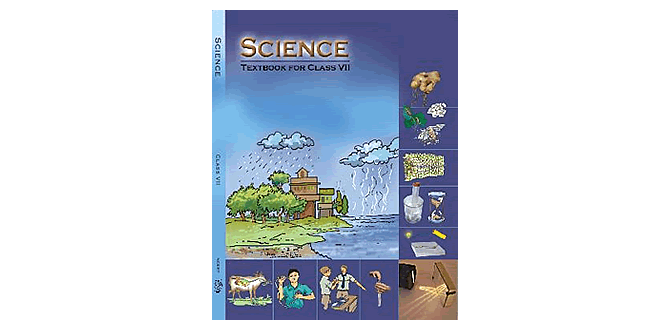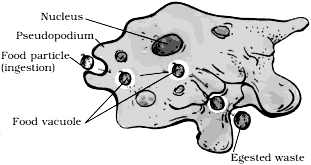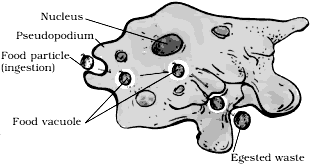Nutrition in Animals NCERT 7th Class CBSE Science Chapter 02
Question: What is the total number of teeth in an adult human?
Answer: In an adult human, there are total 32 teeth.
Nutrition in Animals NCERT – Question: Name the parts of the alimentary canal where
- water gets absorbed from undigested food
- digested food gets absorbed
- taste of the food is perceived
- bile juice is produced
Answer:
- large intestine
- small intestine
- tongue
- liver
Question: Identify the location of salivary gland.
Answer: Salivary gland is present in the buccal cavity and it secretes saliva.
Question: You were blindfolded and asked to identify the drinks provided in two different glasses. You could identify drink A as lime juice and B as bitter gourd juice. How could you do it inspite of being blindfolded?
Answer: Inspite of being blindfolded, one could identify two different drinks with the help of taste buds present in the tongue.
Question: We should not eat hurriedly. Give reason.
Answer: We should not eat hurriedly because if we ingest food in hurry or we talk or laugh while eating we experience hiccups, coughing or choking sensation.
Question: Name the secretions of stomach which digest food.
Answer: The inner lining of stomach secretes mucous hydrochloric acid and digestive juices.
Question: Explain the role of mucus secreted by stomach.
Answer: The function of mucus is to protect the lining of stomach from the action of hydrochloric acid secreted by stomach lining.
Question: The long structure of small intestine is accommodated in small space within our body. Comment.
Answer: The small intestine is about 7.5 metre long It is accommodated in a coiled form inside our body.
Question: Suggest the organ of digestive system where the digestive juices from liver and pancreas is poured.
Answer: The digestive juices from liver and pancreas is poured into small intestine which helps in complete digestion and absorption of food.
Question: From which organ of digestive system, the undigested faecal matter is removed?
Answer: The undigested faecal matter is removed through the anus by the process called egestion.
Question: Mention the position of the rumen in ruminants.
Answer: The rumen is the sac-like structure which is present between small intestine and large intestine in ruminants.
Question: What is assimilation?
Answer: The process by which absorbed food is taken by body cells and is used for energy, growth and repair is called assimilation.
Question: Describe alimentary canal briefly.
Answer: Alimentary canal is the tube running from mouth to anus of human and animals here digestion and absorption of food take place.
Question: Name the simple forms of carbohydrates, fats and proteins.
Answer: The food components and their simple forms are carbohydrates (glucose), fatty (fats) acids and glycerol, proteins (amino acids).
Question: Write the shape of stomach.
Answer: The shape of stomach is like flattened U-shaped.
Question: Discuss the role of hydrochloric acid secreted by gastric glands.
Answer: It helps in the breakdown of food particles. It creates an acidic environment which facilitates the action
Question: With the help of labelled diagram show the gradual decay of tooth.
Answer: Sweets and Tooth Decay The tooth is covered by white, hard outer covering of tooth called Enamel enamel below which dentine is present. It is similar to bone which Pulp cavity (with nerves and blood vessels) protects the pulp cavity having nerves and blood vessels. Bacteria are Gum present in our mouth but they are not harmful to us. However, if we do not clean our teeth and mouth after eating, many harmful bacteria also begin to live and grow in it. These bacteria breakdown the sugars present from the leftover food and release acids. The acids gradually damage the tooth. This is called tooth decay.
Therefore, tooth decay is defined as the process of rotting of tooth and formation of cavity or holes in it which leads to the toothache.
When the holes or cavity reaches to the pulp cavity, it causes pain. If these cavities are not treated on time it causes severe toothache and may result in tooth loss.
Tooth decay can be prevented by adapting following measures.
- One should rinse and clean its teeth thoroughly after every Pulp cavity meal.
- We should clean our teeth with the help of datun or brush Gradual decaying of human tooth and toothpaste, twice a day.
- We should use dental floss which is a special strong thread. It is moved between two teeth to take out
trapped food particles. - Dirty fingers or unwashed objects must be avoided to put in the mouth.
- We should avoid the use of sweets, chocolates, toffees, ice-cream, etc. Much use of cold drink should also be avoided.
Question: Name the various components of food and their simpler forms.
Answer: The various components of food and their simpler forms are:
| Components of food | Simpler form |
| Carbohydrate | Glucose |
| Fats | Fatty acids and glycerol |
| Proteins | Amino acids |
| Vitamins | Vitamins |
| Minerals and water | Minerals and water |
Question: ‘A’ got her gall bladder removed surgically as she was diagnosed with stones in her gall bladder. After the surgery, she faced problems in digestion of certain food items when consumed in bulk. Can you tell which kind of food items would they be and why?
Answer: After surgical removal of gall bladder, ‘A’ would face problems in digestion of fat and fatty substances when consumed in bulk. This is because the bile juice stored in the gall bladder helps in digestion of fats.
Question: Discuss the various associated glands of digestive system and their role in digestion.
Answer: The various associated glands of digestive system and their role in digestion are as follows:
- Salivary gland digestion of starch in mouth.
- Liver secretes bile juices which help in the digestion of fats.
- Pancreas secretes pancreatic juices which act on carbohydrate, fats and proteins and change them into simpler compounds.
Question: Boojho took some grains of boiled rice in test tube ‘A’ and Paheli took boiled and chewed rice in test tube ‘S’. Both of them poured 1-2 drops of iodine solution into the test tube and observed the colour change. What colour change would they have observed? Give reasons for your Answer.
Answer: In test tube A, blue black colour appeared because of presence of starch.
In test tube 6, colour of iodine will not change because of digestion of starch into sugars by the action of saliva in our mouth.
Question: Write the difference between milk teeth and permanent teeth.
Answer: The difference between milk teeth and permanent teeth are
| Milk teeth | Permanent teeth |
| They grow during infancy, i.e. when one is small baby. | They grow at the age of 6-8 years. |
| They are also called as temporary teeth because these are lost at the age of 6-8 years. | They do not fall till the old age. |
| They can be replaced by permanent teeth. | If these teeth fall down no new teeth arises on its place. |
Question: Complete the following table, from the options given below:
(Scraping, chewing, siphoning, capturing and swallowing, sponging, sucking, etc.)
| Name of animal | Kind of animal | Mode of feeding |
| Snail | ||
| Ant | ||
| Eagle | ||
| Humming bird | ||
| Lice | ||
| Mosquito | ||
| Butterfly | ||
| Housefly |
Answer: The complete table is
| Name of animal | Kind of food | Mode of feeding |
| Snail | Leaves and insects | Scraping |
| Ant | Food particles | Chewing |
| Eagle | Small animals | Capturing and swallowing |
| Humming bird | Nectar of flower | Sucking |
| Lice | Blood | Sucking |
| Mosquito | Blood | Sucking |
| Butterfly | Nactar of flower | Siphoning |
| Housefly | All most everything | Sponging |
Question: Boojho and Paheli were eating their food hurriedly so that they could go out and play during the recess. Suddenly, Boojho started coughing violently. Think of the reasons, why he was coughing and discuss with your friends?
Answer: Sometimes when we eat hurriedly, talks or laughs while eating, the flap-like valve (called epiglottis) which closes the passage of windpipe remains open. Therefore, the food may enter into the windpipe. Coughing helps to clear the passage and returns the food particle back to the foodpipe.
Question: Gastric glands in stomach release hydrochloric acid, enzyme pepsin and mucus. What will happen if mucus is not secreted by the gastric glands?
Answer: Mucus protects the inner lining of stomach form the action of hydrochloric acid and enzyme pepsin. If mucus is not released, it will lead to erosion of inner lining of stomach leading to acidity and ulcers.
Nutrition in Animals NCERT – Question: Choose the odd one out from each group and give reasons.
- liver, salivary gland, starch, gall bladder
- stomach, liver, pancreas, salivary gland
- tongue, absorption, taste, swallow
- oesophagus, small intestine, large intestine, rectum
Answer:
- Starch, because rest all are glands and starch is a type of carbohydrate.
- Stomach, because rest all are digestive glands and stomach is a digestive organ.
- Tongue, because rest all are digestive processes and tongue is a part of digestive system.
- Small intestine, because it carriers the process of digestion and rest are not involved in digestion.
Question: Following statements describe the five steps in animal nutrition. Read each statement and give one word for each statement. Write the terms that describe each process.
- Transportation of absorbed food to different parts of body and their utilization.
- Breaking of complex food substances into simpler and soluble substances.
- Removal of undigested and unabsorbed solid residues of food from the body.
- Taking food into the body.
- Transport of digested and soluble food from the intestine to blood vessels.
Answer:
- Assimilation
- Digestion
- Egestion
- Ingestion
- Absorption
Question: Small intestine in herbivores is longer than in carnivores. Do you agree? Support your Answer:
Answer: Yes, carnivores animals cannot digest cellulose, hence they have a shorter small intestine. In herbivores, digestion of cellulose takes a longer time. Hence, herbivores need a longer small intestine to allow complete digestion of cellulose.
Question: Draw a neat and clean diagram of Amoeba showing the correct location of the following components: nucleus, vacuole, pseudopodia.
Answer:
Amoeba
Question: Draw the labelled diagram of tongue showing different region for taste buds.
Answer:
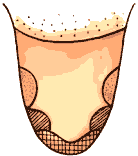
Regions of the tongue for different tastes
Question: Ruminants such as cows and buffaloes swallow their food hurriedly and then sit restfully and chew their food. Give reason.
Answer: Ruminants such as cows and buffaloes swallow their food hurriedly and store it in a part of the stomach called rumen. The cellulose of the food is digested here by the action of certain bacteria which are not present in humans. Later, this partially digested food is returned to the buccal cavity of the animals in small lumps and animal chews it to complete the process of digestion. This process is called rumination.
Question: Discuss the position and number of molars in buccal cavity.
Answer: Molars are very large teeth which are present behind the premolar, towards the back of our mouth. They are only present in the permanent set of teeth and are 6 in each jaw.
Nutrition in Animals NCERT – Question: Name the three digestive glands in our body.
Answer: The three digestive glands are
- liver
- Pancreas
- Salivary glands
Question: The swallowed food moves downwards in the alimentary canal. Explain.
Answer: The swallowed food moves downwards in the alimentary canal because of the atternate relaxation contraction movement of muscles in the wall of foodpipe called peristalsis.
Question: Explain how assimilation is different from absorption.
Answer: The process by which nutrients from the digested food are absorbed by the body is called absorption whereas the process by which the absorbed nutrients are utilized by the body for providing energy is called assimilation.
Question: Food moves in the opposite direction during vomiting. How?
Answer: The intense pressure is formed in the stomach when the food is not accepted by the stomach. The content in the stomach is then pushed back. This returned content is expelled out from the mouth in the form of vomiting.
Question: Briefly explain, why animals like cow cannot chew their food properly at the time they take it in.
Answer: Animals like cow cannot chew their food properly due to the presence of cellulose in their diet. At the time they take in food, the food is moistend and is sent for cellulose digestion and softening in rumen.
Question: Is there any role of liver in digestion of fats? Explain.
Answer: Yes, liver produces bile which has bile salts. These salts break large fat molecules to fine droplets. These fine droplets are further converted into fatty acids and glycerol.
Question: Cellulose rich food substances are good source of roughage in human beings. Justify.
Answer: Cellulose rich food substances are good source of roughage in human beings. It is because the cellulose digesting bacteria are not present in the body of human beings due to which human beings cannot digest cellulose (present in plant foods).
Question: Recall and name the main organs of the digestive system in our body.
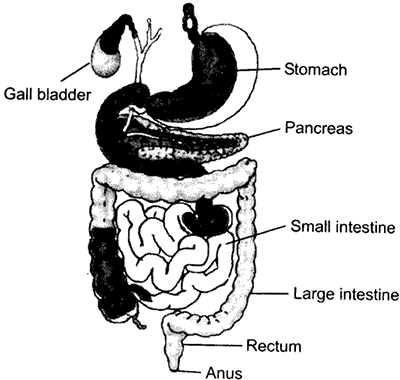
Answer: The different organs of the alimentary canal are as follows:
- Mouth and mouth cavity
- Oesophagus
- Stomach
- Small intestine
- Large intestine
- Anus
Question: Alimentary canal is different from digestive system. Comment.
Answer: Alimentary canal is a long, muscular coiled tube. It is also known as digestive tract. The alimentary canal with its associated glands constitute the digestive system. These glands are salivary glands, liver and pancreas.
Question: Windpipe runs adjacent to the foodpipe. What will happen if food particles enter the windpipe? Explain.
Answer:
The windpipe carries air from the nostrils to the lungs. It runs adjacent to the foodpipe. If, by chance, food particles enter the windpipe, we feel choked, get hiccups or cough.
Question: Explain how is small intestine designed to absorb digested food.
Answer: The finger-like projections called villi are present in the inner walls of the small intestine. The villi increase the surface area. The large surface area of small intestine helps in the rapid absorption of the digested food.
Nutrition in Animals NCERT – Questions Long Answer Type
Question: Label the given figure as directed below in A to D and give the name of each type of teeth.
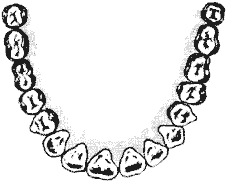
- The cutting and biting teeth as A
- The piercing and tearing teeth as B
- The grinding and chewing teeth as C
- The grinding teeth present only in adult as D
Answer:
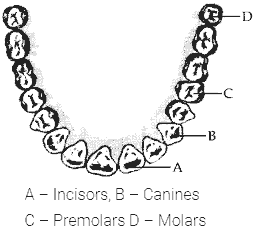
Question: Briefly describe the process of digestion in Amoeba with the help of labelled diagram.
Answer: Feeding and Digestion in Amoeba
Amoeba is a microscopic single celled organism, which is found in pond water. It is a very simple animal and cannot be seen by naked eyes. Amoeba has a cell membrane, a rounded dense nucleus and many small bubble-like vacuoles in its cytoplasm. These vacuoles are of two types, i.e. food vacuole and contractile vacuole. Food vacuole contains food surrounded by water while contractile vacuole contains liquid or water and controls water regulation activity in Amoeba. Its shape is not fixed, i.e. it constantly changes its shape and position. The body of Amoeba has finger-like projections, called pseudopodia or false feet. It captures food and helps in locomotion of Amoeba.
The food of Amoeba are microscopic organisms like tiny plants and animals present in pond water. When Amoeba senses its food, it pushes out pseudopodia around the food particle and engulfs it. The two pseudopodia join around the food particle and trap the food particle with a little water forming vacuole around food, thus the food gets trapped. Digestive juices present inside the vacuole, acts on the food and break it into simpler substances. This digested food is then absorbed and is used for growth, maintenance and multiplication of Amoeba. The undigested food residue is expelled outside by the vacuole. The basic process of digestion of food and release of energy is as similar to the other organisms.
Question: Label the following parts of above figure and name them.
- The largest gland in our body.
- The organ where protein digestion starts.
- The organ that releases digestive juice into the small intestine.
- The organ where bile juice gets stored.

Answer:
Question: Little Rishi (student of class VI) was watching his favorite cartoon serial on television. Suddenly he got hiccups. His elder brother Shubham who was sitting near by him gave him a glass of water and suggested not to eat too fast in a hurry. Little Rishi got confused as he had heard that ‘hichki‘ comes when someone remembers. He asked his father. His father smiled and explained him that it is only a myth. He also explained him the proper scientific reason behind it.
- What is hiccup?
- Why do we get hiccup?
- What are the values shown by Rishi?
Answer:
- Hiccup is a choking sensation that produces a characteristic gulping sound repeatedly. It is called ‘hichki‘ in our local language.
- Sometimes, when we eat too fast in a hurry or talk too much or laugh while eating, then a little of windpipe remains open due to which food particles may enter the windpipe. It may result in a choking sensation called hiccups.
- He is sincere and curious to know about the things at an early age.
Nutrition in Animals NCERT – Question: Jaya returned from school and found that grandmother was scolding her maid, Rani as she did not come yesterday. The maid told that his son was passing watery stools frequently that’s why she didn’t come. Jaya’s mother who was listening the discussion came to them and told Rani not to come for coming 3-4 days. She also suggested her to give his son a solution of sugar and salt in clean water, many times a day for fast recovery. Jaya was surprised. She rushed to her mother and asked the scientific reason for it. Her mother smiled and explained her the importance of this solution.
- Name the term used to describe the condition in which a person passes out watery stools.
- Name the solution of sugar and salt in water. Why is it given to a person suffering from diarrhoea?
- What are the values shown by Jaya?
Answer:
- Diarrhoea
- Oral Rehydration Solution (ORS). It is given to a person suffering from diarrhoea to prevent the dehydration.
- She is sincere, curious and has interest in science.
Nutrition in Animals NCERT – Question: Read the following passage carefully and answer the questions that follow it.
Bile juice is stored in a sac called, gall bladder, located near its organ of secretion, liver. The gall bladder releases the bile juice into the small intestine whenever food reaches there. Though bile juice is devoid of any digestive enzymes, it is required for the digestion of fats. The fats cannot be digested easily because they are insoluble in water and are present as large globules. Bile juice breaks down big fat droplets into smaller droplets. These are then easily digested by the enzymes released from the pancreas
- Which organ secretes the bile juice?
- Why is digestion of fats difficult as compared to that of other nutrients?
- How does bile juice help in digestion of that of other nutrients?
- Where is the digestion of fat completed?
- Does bile juice digest fat completely?
Answer:
- Bile juice is secreted by liver.
- Digestion of fats is difficult as compared to that of other nutrients because of insolubility of fat in water.
- Bile juice helps in digestion of fat by breaking down big fat droplets into smaller droplet.
- Digestion of fat is completed in small intestine.
- No, fat is not completely digested by bile juice.
Question: Define oral rehydration solution and when it is given to the patient? How can you prepare ORS at home?
Answer: Oral rehydration solution is the solution of sugar and salt in a particular ratio in the clean water. When a person passes out watery stools frequently, the disease is called diarrhoea. In this condition there is a loss of water and salt from the body of a person.
This is called dehydration which may be fatal if not cured at proper time. In order to prevent dehydration, the person or patient should be given ORS. ORS makes up the loss of water and salts in the body and sugar provides energy which helps in the recovery of disease. It should be given to a patient suffering from diarrhoea at a regular interval.
At home the ORS can be prepared by dissolving a teaspoonful of sugar and pinch of salt in a glass of clean water. The water used for preparing ORS should be first boiled and then cooled so that all the microorganisms or harmful bacteria may be killed.
Question: Open your mouth, look into a mirror and try to count the different types of teeth of teeth in your mouth. Compare them with figure 2.3 on page 13 of your NCERT textbook. Record your observations in the table below:
| Type of teeth | Number of teeth | |
| In my mouth | In the figure | |
| Incisors | ||
| Canines | ||
| Premolars | ||
| Molars |
- Did you observe any difference in the number of teeth? If yes, could you identify which type of teeth showed the difference?
- Compare the number and type of teeth in an adult (say your parents or cousins who have reached the age of 25-30 or more). Note your observation.
Answer:
| Type of teeth | Number of teeth | |
| In my mouth | In the figure | |
| Incisors | 4 | 4 |
| Canines | 8 | 8 |
| Premolars | 8 | 8 |
| Molars | 8 | 12 |
- Yes, the difference has been observed in the number of molars.
- The number and type of teeth varies in an adult as compared to the child. Children have 28 teeth in their mouth. There are only four molars in each jaw.
While, adults have 32 teeth in their mouth which means six molars in each jaw.
Question: Explain how the digestion of cellulose occurs in grass eating animals.
Answer:
Digestion in Grass-Eating Animals
The herbivorous animals such as cow, buffaloes, etc eat grass. These animals quickly swallow the grass and store it in a part of stomach called rumen. The food is not chewed completely. Rumen possess cellulose digesting bacteria which breakdown the food by fermentation. This partially digested food or grass present in the rumen of cow is called cud.
This cud is brought back into the mouth of the cow from the rumen into small lumps and animal chews it again. This process is called rumination and animals are called ruminants.
When this cud is thoroughly chewed in the mouth of the cow, it is swallowed again. This time the chewed cud does not go back to rumen but enter into the other compartments of cow’s stomach and then into the small intestine for complete digestion and absorption of food. The cellulose digesting bacteria are not present in the body of human being, therefore human beings and other carnivore cannot digest cellulose present in plant food items.
Fill in the Blanks
Nutrition in Animals NCERT – Question: ……. is the process of taking food inside the body.
Answer: Ingestion
Question: ….. is the simplest form of carbohydrate.
Answer: Glucose
Question: The process of breakdown of complex food material into …… is called …….
Answer: simpler form, digestion
Nutrition in Animals NCERT – Question: Amoeba digests its food inside ………
Answer: food vacuole
Question: ……. teeth replaces the milk teeth.
Answer: Permanent
Question: …… is the long tube-like structure which
Answer: Alimentary canal
Question: Large intestine absorbs ….. and …… from undigested food.
Answer: water, salts
Question: Animals are …….
Answer: heterotrophic
Question: Cud chewing animals are called ……..
Answer: ruminants
Question: Four kinds of teeth present in human are ……, …….., …….. and ……..
Answer: incisor, cannines, premolar, molar
True / False: Nutrition in Animals NCERT
Question: Oesophagus is also called as foodpipe.
Answer: True
Question: Simplest form of fat is sugars and glucose.
Answer: False, simplest form of fat is fatty acid and glycerol.
Nutrition in Animals NCERT – Question: Ruminant can digest cellulose (carbohydrate).
Answer: True
Question: Canines are used for grinding of food.
Answer: False, canines are used for piercing and tearing the food.
Question: Amoeba is a microscopic, single celled animal.
Answer: True
Question: The nutrition in Amoeba takes place by pseudopodia.
Answer: True
Question: Egestion is the process of removing waste food or undigested food through anus.
Answer: True
Question: Diarrhoea can be treated by only giving water to the patient.
Answer: False, diarrhoea can be treated by giving a solution of sugar and salt in the clean water for several times in a day. This solution is called ORS.
Nutrition in Animals NCERT – Question: Source of energy for living being is food.
Answer: True
Question: The digestion of starch only takes place in the stomach
Answer: False, digestion of starch normally begins in the mouth where it is broken down into smaller sugar molecules, glucose. Additional breakdown of starch occurs in the small intestine.
Question: Match the Column I with Column II.
| Column 1 | Column II |
| (a) Rectum | (i) Mucus |
| (b) Gallbladder | (ii) Villi |
| (c) Stomach | (iii) Taste buds |
| (d) Tongue | (iv)Faecus |
| (e) Small intestine | (v) Bile juice |
Answer: (a)-(v), (b)-(vi), (c)-(i), (d)-(vii), (e)-(ii), (f)-(iv), (g)-(iii)
Nutrition in Animals NCERT – Question: Match the Column I with Column II.
| Column 1 | Column II |
| (a) Amoeba | (i) ORS |
| (b) Incisors | (ii) Bile juice storage |
| (c) Diarrhoea | (iii) Release of faecus |
| (d) Fat | (iv) Cud chewing animals |
| (e) Gall bladder | (v) Pseudopodia |
| (f) Ruminants | (vi) Cutting and biting |
| (g) Anus | (vi) Fatty Acid and Glycerol |
Answers: (a)-(iii), (b)-(i), (c)-(iv), (d)-(ii)
 Class Notes NCERT Solutions for CBSE Students
Class Notes NCERT Solutions for CBSE Students
